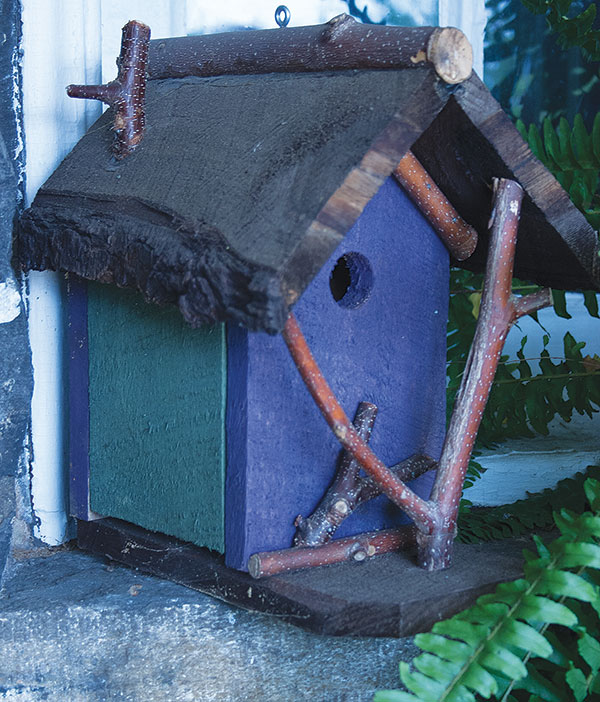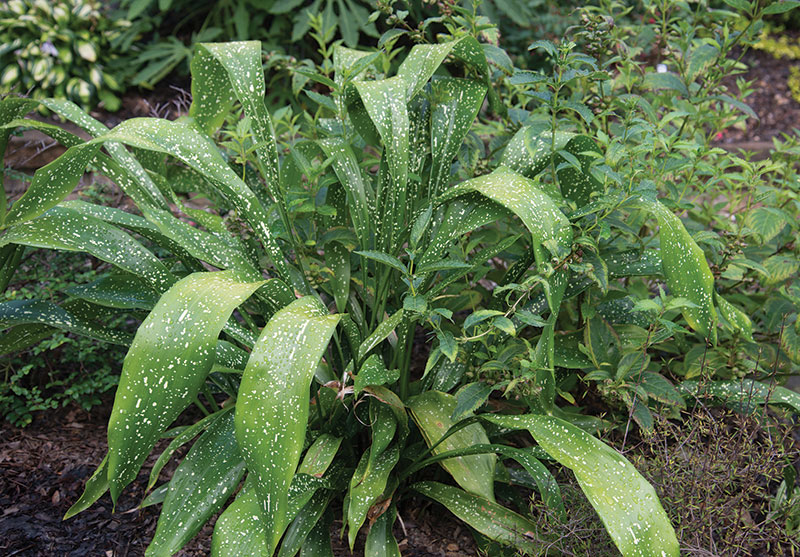The cast iron plant (Aspidistra sp.) is as advertised because only a dedicated, demented brown thumb gardener has even the remotest chance of killing it. This is a tough plant that can take plenty of abuse and neglect while remaining constantly pretty in almost any indoor setting. Its long, strap-like, deep green, shiny leaves pleasantly fill blank spaces in drab rooms.
And history tells us that this sturdy plant also does well in low-lit areas because it was a big hit during Victorian England, where its displays remained resplendent even in dark, pre-electric-light parlors. In fact, about the only place this Far East import will tend to suffer is in direct sunlight.
It doesn’t take much to keep a cast iron plant happy. Watering it when the upper inch or two of potting soil is dry to the touch is about all that is required, although adding a diluted fertilizer solution every few months will encourage better leaf production. Also, repotting is seldom necessary; this slow-growing plant will usually do just fine in a midsize, 8- to 10-inch diameter pot.
More than plain green
But if there is a knock against the cast iron plant, it would be that it is green — just plain green, ho-hum green. Or so it would seem. One of the secrets of this plant is that there are many variegated cultivars delightfully sprinkled, sprayed, smeared or swiped in contrasting hues that range from pale white to golden yellow. For gardeners who like to see spots before their eyes, popular selections like ‘Spek-tacular,’ ‘Leopard,’ ‘Milky Way’ and ‘Golden Freckles’ will add the appropriate pizzazz, while lovers of streaked leaves can enjoy pretty picks such as ‘Variegata,’ ‘Snow Cap,’ ‘Gold Lancer’ and ‘Lennon’s Song.’ Quality local nurseries will probably have a few different variegated cast iron plants to pick from, but if you would rather let your fingers do the e-walking, Plant Delights Nursery (plantdelights.com) offers an extensive list of selections.
Give it a chance outside
Cast iron plant has one more secret. With this beauty being such an easy plant to grow indoors, many gardeners might think of it simply as a reliable houseplant, but there are multiple selections that will not only survive outdoor conditions but thrive through all four seasons in this region of the Southeast. Many of these are hardy cultivars from the common species Aspidistra elatior, but other species have been found to be reliably rugged for Southern landscapes and are now making their way into garden centers and online shops.
Areas of dry shade seem to be ideal outside growing spots, while soggy, constantly wet sites or sunny locations are less desirable. Cast iron plant leaves can brown if they are relentlessly exposed to arid, below freezing winds, but a spring snipping of any desiccated vegetation will quickly remove the ugly bits and even encourage a flush of new foliage.
Now it is no secret that cast iron plants can be very reliable additions to any gardener’s green world, either inside or out, and their many beautiful variegated forms show that such steadfast consistency can be sassy too!

Now is a good time to clean out, repair, repaint or even replace any birdhouses that served your local population of flying friends well last year. However, don’t be too quick to tinker with or pull down any of these miniature retreats.
While birdhouses are mainly thought of as spring nesting boxes, many cavity-roosting birds such as wrens, chickadees, titmice and bluebirds also see them as comfortable winter havens.
So take a few days to watch the houses for signs of activity on the wing before doing any necessary maintenance.
To Do in the Garden
January
- Trouble could be brewing with your houseplants. Watch for the appearance of common pests such as mealy bugs, whiteflies and spider mites, which can become active in the balmy, cozy conditions of a winter home.
- More trouble could be in store for your houseplants if you are watering them straight from the tap this winter. C-c-c-cold water can shock sensitive plants, which could result in the loss of leaves. Allow water to warm to room temperature in a container before pouring in houseplant pots.
- Things might not be looking rosy from a weather standpoint right now, but bare-root roses (which can be planted in the late winter) will begin to appear at quality garden centers at the end of this month.
- For a little bit of cold-season exercise, go out and turn the compost pile over one more time. Also, to allow the sun to help add heat to the heap, cover the pile with a sheet of clear plastic.
- If the weather is especially cold this month, pansies will languish in the landscape. Don’t give up on them, however. Continue cutting off spent blooms and, at the end of this month, encourage them by applying a weak fertilizer solution consisting of one tablespoon of 8-8-8 or 10-10-10 in a gallon of water.
- If you use a cold frame to protect plants and propagated cuttings in the winter, keep in mind that, even on the coldest of days, such an enclosure can really heat up on sunny days. So whenever the sun shines this winter, open the frame just a bit to help keep temperatures from rising too high.
- A New & Improved You
- Secrets of the Cast Iron Plant
- Easy as Pie
- Oven-Roasted Cauliflower from Tazza Kitchen
- Not a Moment to Lose: The V Foundation
- 2017 Maggy Awards: Lifestyle
- Presenting the 2017 Maggy Awards!
- 2017 Maggy Awards: Restaurants
- 2017 Maggy Awards: Services
- 2017 Maggy Awards: Shopping
- Still Raising a Ruckus
- Back to Work
- A Taste of Sweet Potato Pie








My young spider web fatsia has nice full leaves at the top, but the bottom leaves sometimes turn black and die, resulting in a nice top, then about six inches of bare stem, then more new healthy growth. Could they be in a spot that is too moist?